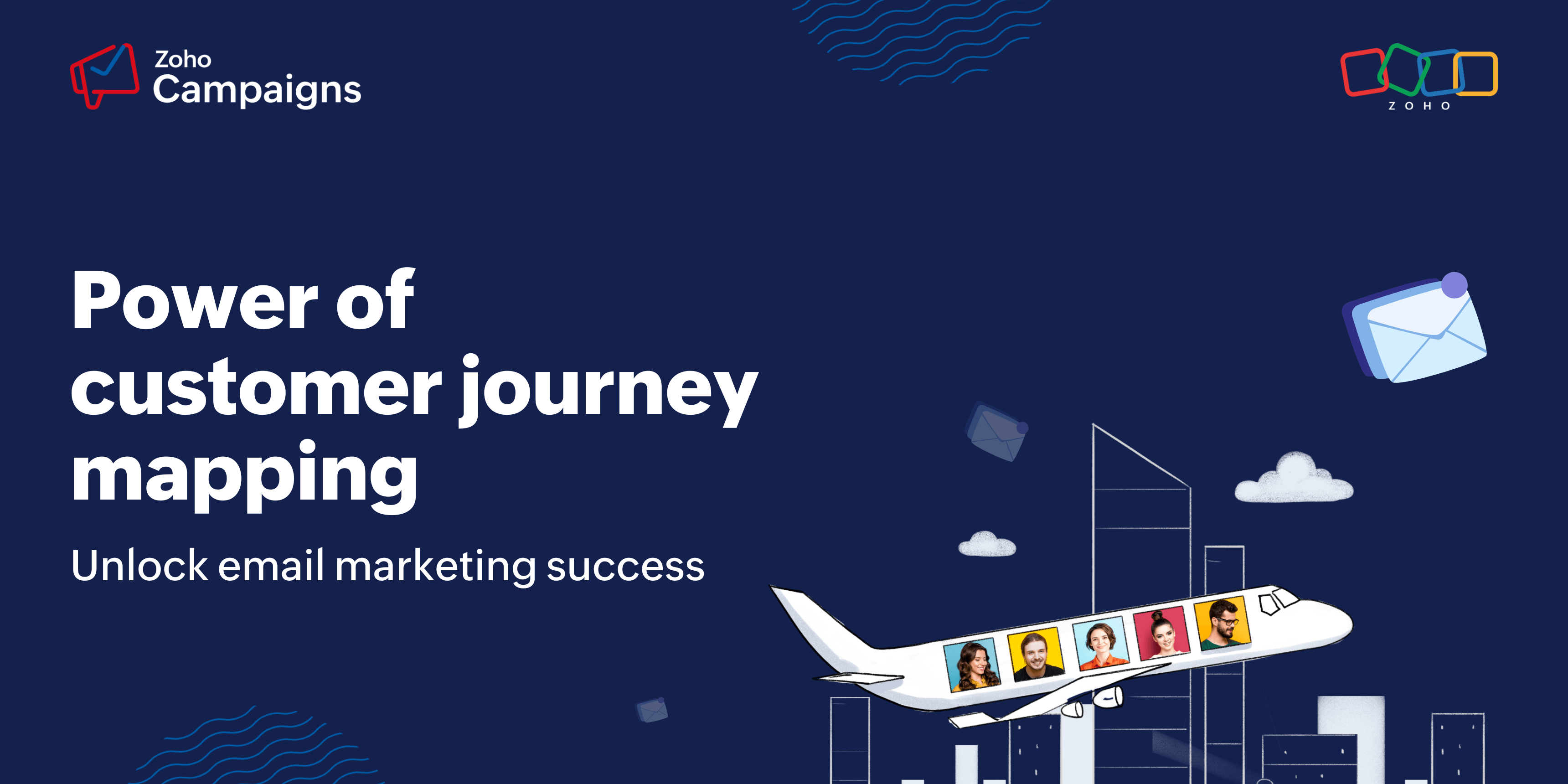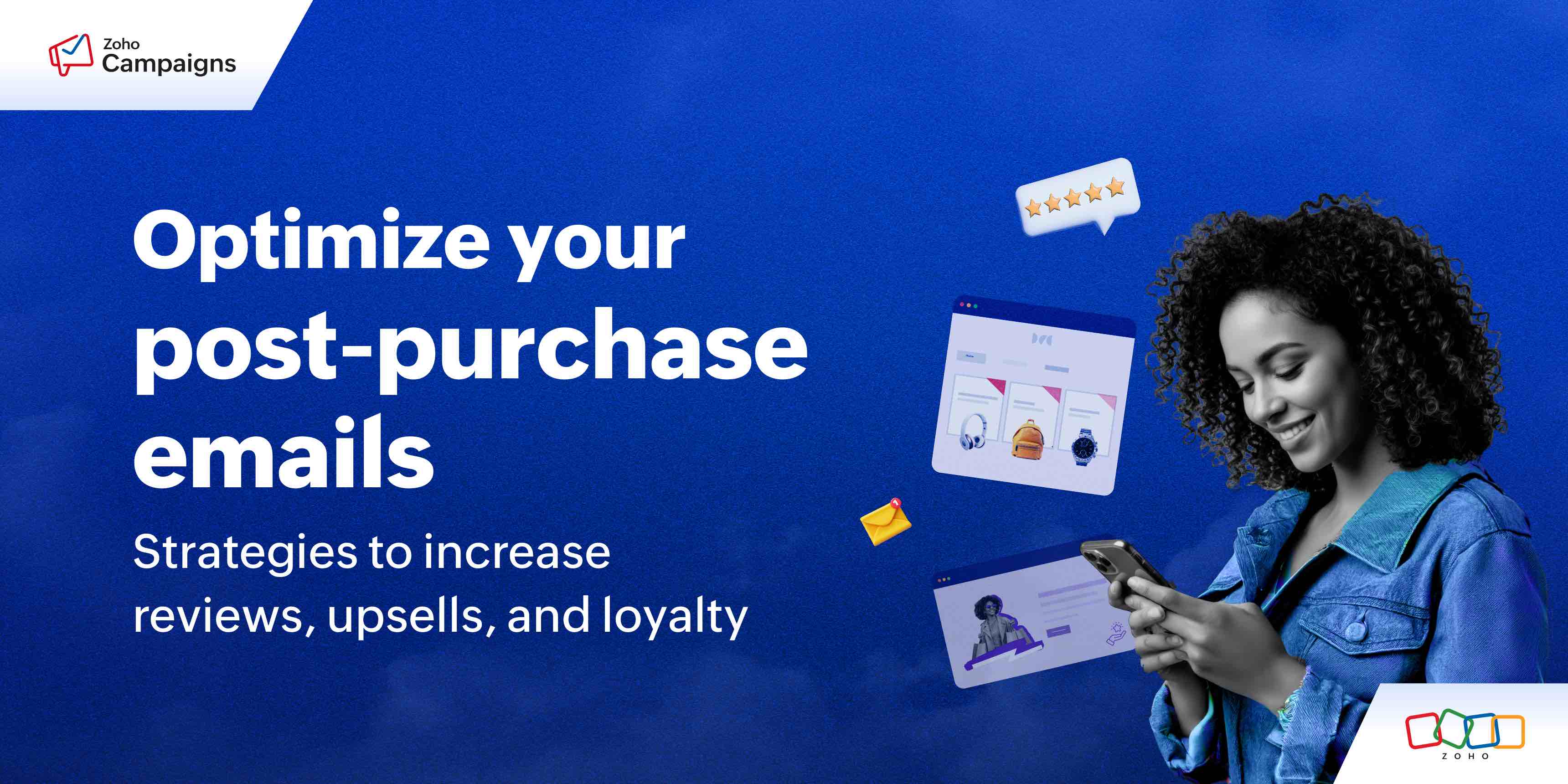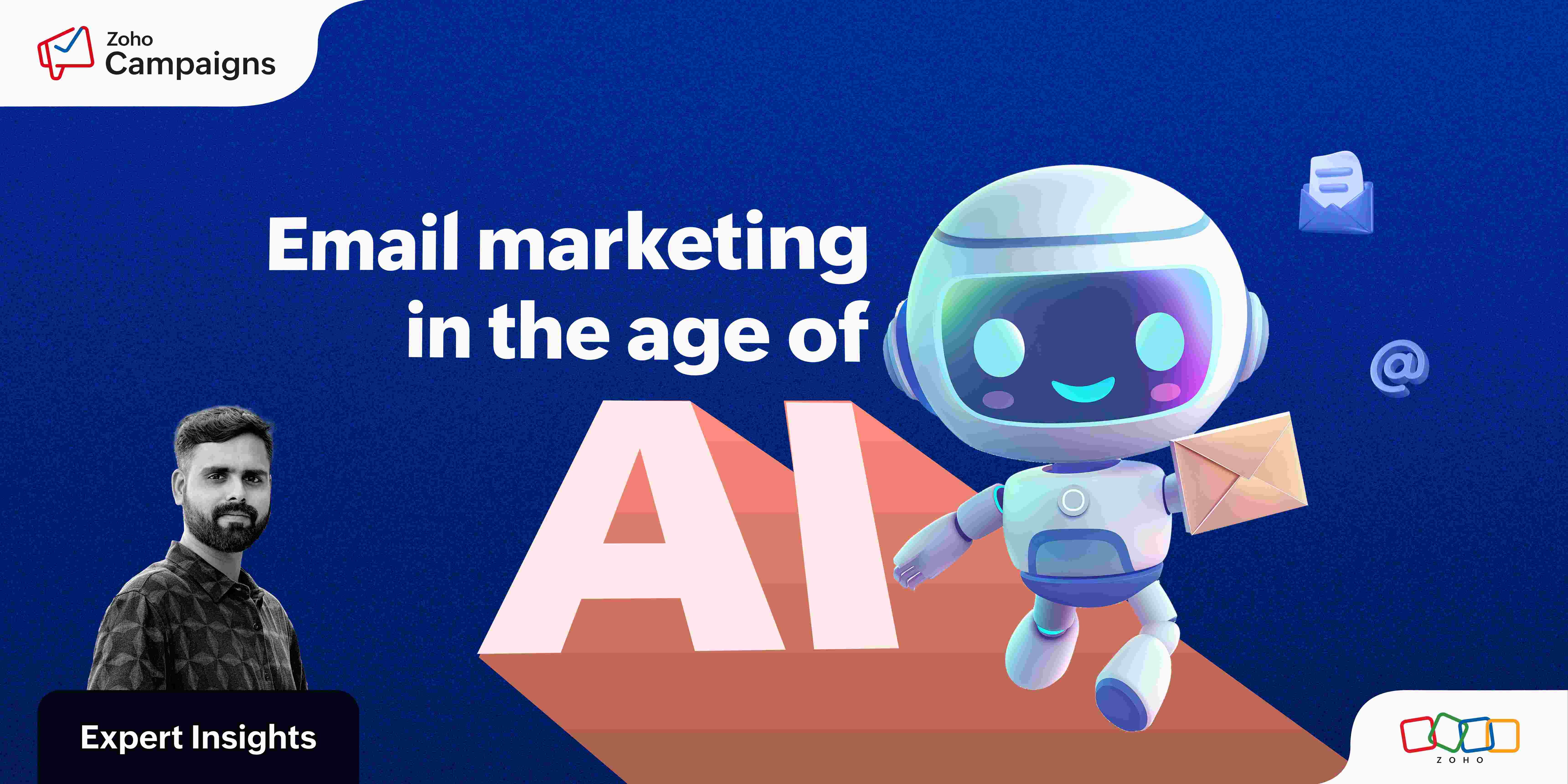- HOME
- Email Marketing
- Customer journey mapping for email marketing
Customer journey mapping for email marketing
- Last Updated : June 7, 2024
- 1.3K Views
- 9 Min Read

If you're running a business, you are likely sending emails not only to customers but also to prospects with hopes of increasing your sales. But have you ever taken a step back and thought about the emails you send and how each one plays a role in the grand scheme of things?
If one of your emails turned a prospect into a customer, congratulations! While that email may have heavily influenced them into making a decision, that was probably not the only catalyst. Every customer of yours has been on a journey of their own, starting from discovering your brand to finally making the purchase decision.
It is this customer journey that this article is going to dive into, only from the lens of email marketing. It will go over what customer journey mapping is and how you can use it to leverage your email marketing game (and in turn, increase sales).
What is a customer journey?
The customer journey comprises all the touchpoints a person goes through before they decide to make a purchase from you. A customer journey is different from a buyer journey in the sense that a buyer journey is a generic one. It starts from creating awareness or intent about the general solution for the buyer's problem and ends with making a purchase or even becoming an advocate; whereas a customer journey is the points along the path where your brand is directly under consideration.
Pro tip: Social media posts, videos, reels, reviews, conferences, webinars, blogs, webpages, email campaigns, advertisements, referrals, comparison sites, landing pages, testimonials, and case studies are all examples of customer touchpoints.
(Bonus tip: You can share snippets or links to all these touchpoints through your emails to prospects.)
Customer journey funnel
Before learning more about mapping the customer journey, it's best to first look at a basic customer journey funnel to get an overall understanding of the process.
A typical customer journey starts from the awareness stage, where the prospect first becomes aware of the solution or products available to solve their problems. When they learn of your offering, they might show interest in learning more. The prospect then moves on to the consideration stage, where your product is directly under consideration among other competitors. At this point, the prospect is evaluating the pros and cons of multiple solutions and trying to decide which one would work best for their needs.
Finally, the prospect makes the purchase decision, but the journey doesn't quite end at this point. The next stages are loyalty and advocacy. Loyalty is when a customer continues purchasing from you and really loves your product or service. Advocacy happens when your customer likes you so much that they actively bring in more customers to your business through referrals.
While this process is linear on paper, it is seldom so in real life. Customers do not jump from one stage to the next by just reading a blog post or a comparison document. Multiple touchpoints are involved at every stage, and people jump forward and backwards between stages. This makes customer journey mapping all the more crucial, so you can understand what happens at every stage and ensure more prospects convert.
Benefits of mapping the customer journey for email marketing
Take control over the buying process
Mapping your customer journey doesn't mean you are merely tracing how your customer travels from discovery to advocacy. It means you are not leaving the customer's purchase decision to chance. You are taking ownership for the entire journey to make more prospects say "yes" to becoming customers at the end of the journey.
Identify gaps in the journey
You can create any number of resources to be used across the customer journey, but how do you figure out which one would be needed and when? Mapping the journey will throw light on gaps in the journey and, in turn, help you map the right resource to be delivered to the customer at the right time.
Create new areas of opportunity
Mapping your customer journey will help you discover new customer touchpoints that you have previously not paid attention to. For instance, you have a great loyalty program that your prospects don't hear enough about. Talking about this during the consideration stage might sway more prospects into saying "yes" to you.
Create personalized journeys
By customizing the content to the stage of your customer's journey, you can make them feel seen and connect with them on a personal level. If a certain prospect has shown interest in case studies, you might want to send them more in-depth case studies about their use case to help them make their decision faster.
Increase campaign effectiveness
When you send highly personalized and relevant content based on the prospect's stage along the journey, you can increase opens, clicks, and conversions.
By mapping your customer's journey and using it for email marketing, you take ownership for every touchpoint andpossible opportunity for brand awareness, make sure you convey the right message, and initiate the right kind of conversations. In essence, you leave no stone unturned to ensure a smooth customer journey.
How to map the customer journey
When you create a big picture of your customer journey, creating your email journey becomes much easier. Depending on where your prospect is in the customer journey, you can customize your email journey with appropriate nudges to make them take a step in the right direction.
To map your customers' journey, you'll need data. To sort through or even begin to collect this data and make sense of it, you'll need to know the journey and the touchpoints. It seems paradoxical, but is not impossible.
How to create a customer journey map for email marketing
1. Leverage data to understand customers
Collect all the data you have on your prospects and customers. Tap into social media accounts, ad accounts, CRM, websites, support desk logs, emails, and whatever else you can get your hands on. Having all this information will help answer questions about your customer journey and create an informed customer journey map.
2. Define ideal customer personas
Answer these questions: Who is your target audience? What job roles are they in? What are their interests and motivations? What are their biggest pain points? The answers will help you paint detailed pictures of your typical customer personas. If you have multiple products or services, then you can have a set of two to three ideal customer personas for each business offering.
3. Map customer journey stages
While the AIDA funnel (Awareness, Interest, Consideration, and Decision) is a basic guideline, the stages of the customer journey in your context might be very different. For an ecommerce site, for instance, a prospect might just see a product on an advertisement, like it, and just buy it. So, just awareness turns into a purchase decision. But for a B2B business, getting stakeholder buy-in is a separate stage of the customer journey. Therefore, look at previous purchases to understand how your customers go about the journey.
4. Identify customer touchpoints
Now it's time to identify where along these stages you have customer touchpoints. Be it advertisements, social media, newsletter signups, product review sites, or an ebook download, map every single touchpoint where a prospect has the opportunity to learn more about your company or your offerings. Remember that not every touchpoint will be under your control. For instance, a prospect might be looking at product comparisons, and a competitor might write a product comparison article featuring your product. While such a touchpoint might not always be in your favor, identifying these will help you take counteractive measures.
5. Create customer journeys for email marketing
Well, now that you have your customer personas, their journeys, and the touchpoints along the journey, it's time to jump into action. Use all this information to create detailed workflows for every customer journey and touchpoint. Decide which touchpoints you're covering for every stage of the journey for each audience segment, and create an email workflow covering these touchpoints. Have a clear goal for every email, focus on that goal within the email content and make sure the call to action (CTA) of the email is related to the touchpoint you want to take your customer to.
6. Implement and iterate customer journeys
As your prospects and customers go through these journeys, you will find that some journeys and touchpoints work better than others. Keep iterating, testing, and measuring the results of these changes to increase the success of your customer journey-focused email campaigns.
Examples of email marketing customer journey workflow
If you're looking to learn how to write highly engaging emails, take a look at our article on tips and tricks to increase engagement.
Since getting the workflow for the emails right is as important as (if not more) writing emails, here is how you can set up a workflow. For this example, we've shown a workflow setup using Zoho Campaigns. Try Zoho Campaigns for free here.
Workflow triggers
You first need to set up triggers for the workflow to activate. The trigger can be time-based, activity-based, or condition-based. So whenever a certain time has passed, or a certain action happens, or certain conditions are met, your workflow can start.
As shown in the image below, we're setting up a condition that starts whenever a person downloads an ebook from the website and enters an email address while filling out the form. With that, they get added to the list "Ebook leads." From here, you can trigger the workflow for ebook leads nurturing to begin whenever a contact is added to this list.

Alternatively, you can also set up the triggers directly in your workflow. Let's look at one.
Product trial customer journey workflow
Let's now look at the email marketing customer journey for a product trial.
When a prospect signs up for the trial, they enter a specific list created for this journey. As soon as the contact joins the list, an email is triggered. This could be your typical welcome email introducing your company and your product. The CTA of this email could be touchpoints such as how-to videos and help documents.

While most prospects will open the emails (as they've willingly opted for the trials), some might not. For those who have opened the emails, you can safely assume they're continuing to show interest in the product. You can trigger anotheremail with more links to maximize product usage to help the prospect discover how good your product is.
For those who haven't opened the email, you can set a different welcome email nudging them to try the product.

After you trigger another email for the prospects who skipped your first welcome email, you set a condition. Those who open this email go back into the product trial nurture series. For those prospects who skip this email again, you can trigger a final email.

After the third skip, you can remove the prospect from this workflow and focus on the other prospects.

You can also remove uninterested prospects from this list and move them to a different workflow altogether.

Meanwhile, for the prospects who are actively engaging with your emails, you can remind them that the trial period is about to end soon. In the email, you can offer them an extension of the trial, or a free call with the support team if they need more help figuring out the product.

Once the trial period has ended, you can trigger a survey campaign to understand whether the prospect found the product useful and understand their pain points. Based on their responses, you can optimize the product trial journey. You can also trigger a similar survey for the unengaged prospects to understand why they didn't engage.
You can also create other workflows for journeys starting from different touchpoints like these:
Newsletter sign up journey
Contact signs up for the newsletter → Send helpful and relevant newsletter emails → Encourage readers to share newsletter through social sharing buttons → Nudge prospects to try your product or service.
Ecommerce product purchase journey
Purchase a product → Send order confirmation → Send order status → Send delivery confirmation → Ask for feedback → Ask customers to refer to friends using a special discount code.
Webinar sign-up journey
Person signs up for webinar → Send confirmation → Send 10-day reminder → Send 3-day reminder → Send day-of-webinar reminder → Send reminder at the start of webinar → Send recording post-webinar → Send free trial email.
Upsell or cross-sell journey
Customer makes a purchase → Send confirmation mail → Send recommendations on complementary products or packages → Send limited-time offer on the related product.
Customer loyalty and advocacy program journey
Welcome customer to loyalty program → Encourage more purchases to earn more points → Provide timely updates aboutreward points → Offer exclusive perks or early access → Offer more rewards for referrals
Conclusion
Email marketing will always be a powerful tool for businesses of all sizes, but too many emails aimed at everyone don't yield results. Understanding the customer journey and tailoring your email campaigns accordingly will help you optimize your customers' journey. From initial contact to conversion and even advocacy, a well thought out email campaign will transform email marketing, taking it from a promotional tool to one that lets you build an everlasting relationship with your customers.
 Vidhya Vijayaraghavan
Vidhya VijayaraghavanHi! I'm Vidhya, a storyteller and problem solver. I wholeheartedly believe that B2B content doesn't have to be boring.
When not writing or having a writer's block, you can catch me reading, puzzling, or volunteering.
I'm game for a conversation about anything, especially B2B SaaS marketing (and cats too!).



